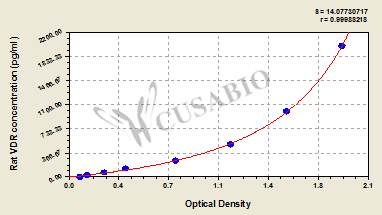| Code | CSB-EL025832RA |
| Size | 96T,5×96T,10×96T |
| Price | Request a Quote or Start an on-line Chat |
| Trial Size |
24T ELISA Kit Trial Size (Only USD$150/ kit) * The sample kit cost can be deducted from your subsequent orders of 96T full size kits of the same analyte at 1/5 per kit, until depleted in 6 months. Apply now |
| Intra-assay Precision (Precision within an assay): CV%<8% | |||||||
| Three samples of known concentration were tested twenty times on one plate to assess. | |||||||
| Inter-assay Precision (Precision between assays): CV%<10% | |||||||
| Three samples of known concentration were tested in twenty assays to assess. | |||||||
| To assess the linearity of the assay, samples were spiked with high concentrations of rat VDR in various matrices and diluted with the Sample Diluent to produce samples with values within the dynamic range of the assay. | |||||||
| Sample | Serum(n=4) | ||||||
| 1:1 | Average % | 89 | |||||
| Range % | 84-93 | ||||||
| 1:2 | Average % | 101 | |||||
| Range % | 98-105 | ||||||
| 1:4 | Average % | 96 | |||||
| Range % | 93-99 | ||||||
| 1:8 | Average % | 105 | |||||
| Range % | 101-109 | ||||||
| The recovery of rat VDR spiked to levels throughout the range of the assay in various matrices was evaluated. Samples were diluted prior to assay as directed in the Sample Preparation section. | |||||||
| Sample Type | Average % Recovery | Range | |||||
| Serum (n=5) | 84 | 81-89 | |||||
| EDTA plasma (n=4) | 95 | 91-99 | |||||
| These standard curves are provided for demonstration only. A standard curve should be generated for each set of samples assayed. | ||||||||||||||||||||||||||||||||||||||||||||||||||||||||||||||||||||||||

| ||||||||||||||||||||||||||||||||||||||||||||||||||||||||||||||||||||||||
The Rat Vitamin D3 receptor (VDR) ELISA kit is a powerful tool for researchers in the field of metabolism,immune response,cancer research. This quantitative assay measures the concentration of Vitamin D3 receptor (VDR) in serum, plasma, and tissue homogenates from Rattus norvegicus (Rat) samples.
With a detection range of 31.2 pg/mL to 2000 pg/mL and a sensitivity of 7.8 pg/mL, this ELISA kit provides accurate and reliable results for your research needs. The assay time ranges from 1 to 5 hours, and the sample volume required is 50-100ul.
The sandwich measurement technique used in this kit ensures high specificity and sensitivity, providing you with confidence in your results. The detection wavelength of 450 nm ensures accurate measurements for each sample. With more than 3 citations to its name, this ELISA kit has been validated by researchers around the world.
There are currently no reviews for this product.